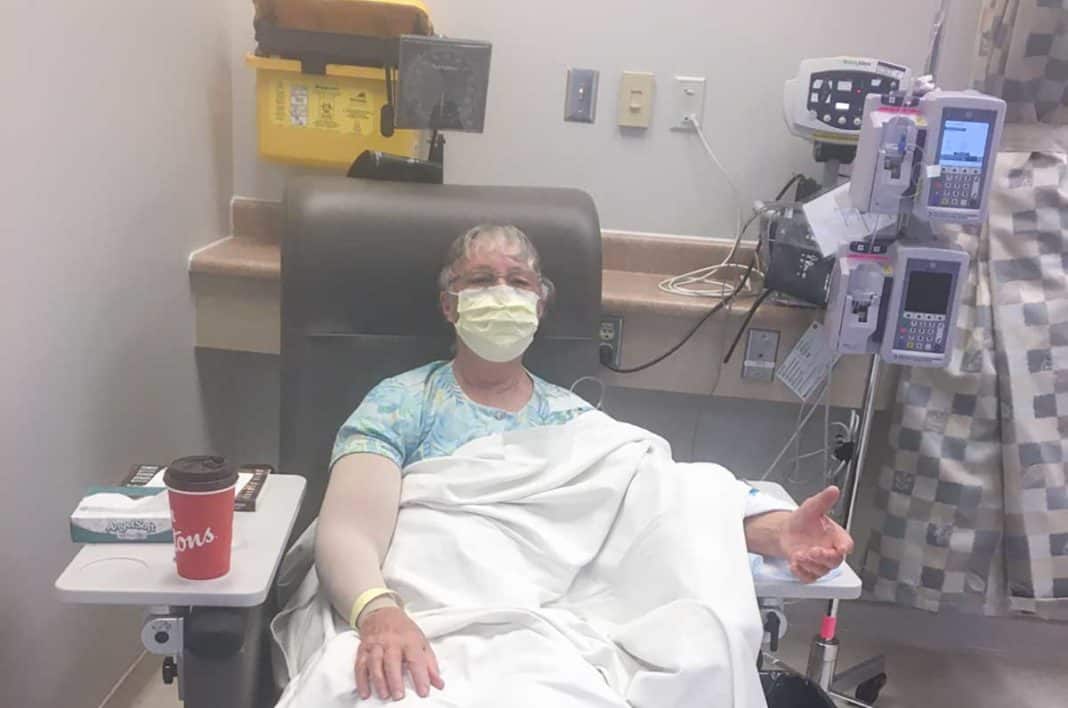Chemotherapy begins for an upbeat Mary Buie
EDITOR’S NOTE: In 2013 retired nurse and midwife Mary Buie approached The Expositor with a mission. She had recently been diagnosed with breast cancer and was wondering whether this newspaper would be interested in following her journey as she battled the disease. It was with some trepidation that this paper agreed as the eventual outcome was far from certain to be positive. What followed was an engaging series that leavened a very serious health issue with Ms. Buie’s irrepressible personality. Ms. Buie recently informed The Expositor that she would once again be facing down cancer. The Expositor is restarting the series ‘Following Hope’s Path’ to continue relaying the story of her journey.
KAGAWONG – Mary Buie sits back in her recliner, snuggled beneath a warm blanket and wearing comfy socks, while poison courses through her veins. It’s chemo time and Ms. Buie has some time to chat with The Expositor as she continues her journey, ‘Following Hope’s Path.’
“I am wearing llama socks in the chemo room,” she laughs. “I asked my family to send me fun crazy socks to get me through this chapter of my life, so here I am having some fun in the chemo room with crazy socks.”
Ms. Buie enjoyed a chemo holiday last week, having just completed a three-week stint. “It’s three weeks on and one week off to let my body adapt,” she said when The Expositor checked in with her. “So I’ve a lot of energy this week as the taxol moves out of my system.”
Taxol, she explains, is an anti-cancer (an antineoplastic or cytotoxic in scientist speak) chemotherapy drug. Taxol is a taxan and an antimicrotubule agent (which basically means the drug stops cells from dividing). It’s also extremely poisonous.
“You have to be very careful when you are going to the bathroom or anything you touch,” she said.
Some of the side effects Ms. Buie experiences while undergoing chemotherapy can be quite alarming in these days of pandemic—particularly the loss of taste, a common experience from COVID-19. “I can taste,” she shared during her week off, “but I can’t when it is in my system. So right now I am celebrating the fact that I can taste.” There is nothing quite like enduring rounds of chemotherapy to make you appreciate the little things in life.
For someone who is facing down a life-threatening cancer for the second time in her life, Ms. Buie remains her upbeat self. “I am enjoying this chapter in my life,” she admits. “I don’t have many side effects like so many people.”
Those side effects (from Taxol) include low blood counts as your white and red blood cells and platelets may temporarily decrease, putting you at increased risk for infection, anemia and/or bleeding; arthralgias and myalgias (more scientist speak, that basically means pain in the joints and muscles. Usually temporary occurring two to three days after Taxol, but should resolve within a few days). Peripheral neuropathy, that’s numbness and tingling of the hands and feet, nausea and vomiting (usually mild), diarrhea, mouth sores and hypersensitivity reaction, ie) fever, facial flushing, chills, shortness of breath, and/or hives. The majority of those reactions occur within the first 10 minutes of the infusion.
“I am starting to experience the hair loss,” admitted Ms. Buie. “I haven’t lost much yet, but it is starting.” She is also experiencing some of the neuropathy, but it is mild.
“It’s just a bit of tingling in my fingers and toes,” she said. “But I am not sick. When you go for chemotherapy you can look sick, but while I may have the enemy within, I am not sick.”
But when The Expositor caught up with her in the chemo room, Ms. Buie admitted to feeling “a bit tipsy.” It seems one of the side effects of the chemotherapy is “chemo fog. I feel tipsy most of the time.”
Ms. Buie said that she enjoys interacting with the staff in the chemotherapy room. “They are such a wonderful, caring group of people,” she said. “There are 21 chairs in the chemo room, so there are a lot of older people here. I see a lot of older people, a lot of sick people who are undergoing chemotherapy or immunotherapy.” Since she is definitely not sick, Ms. Buie said that she is happy to travel to Sudbury for her treatments. “Let the sick people use the one in Mindemoya so they don’t have to travel.”
Still, Ms. Buie wasn’t all that unhappy to learn that she will be able to take her next course of chemotherapy in Mindemoya. Just don’t call her sick!
Ms. Buie wore her bunny ears during her last course of treatment in Sudbury. “The staff were all upset they didn’t have their bunny ears on,” she laughed. “Bunny ears and crazy socks, I like to make people happy.”
Ms. Buie had high praise for the army of volunteers who help make the chemo room at Health Sciences North a warm and inviting atmosphere. “You get served by the volunteers,” she said, “they bring the warm blankets (intravenous injections can make you quite cold) and cookies.” There’s television to distract and keep a patient’s attention occupied as well.
Warm pads over the injection site also helps. The pads are there to help soften the veins where the intravenous tubes are placed. “They give you prednisone to help the chemotherapy work,” she noted. “It’s more effective.”
One of the common side effects from the chemotherapy sessions are what is called “jumpy legs” that can make sleeping a bit of a challenge. But Ms. Buie is grateful she does not require a PICC line. A PICC line is a thin, soft, long catheter (tube) that is inserted into a vein in the arm, leg or neck. The tip of the catheter is positioned in a large vein that carries blood into the heart. The PICC line is used for long-term intravenous antibiotics, nutrition or medications and for blood draws. In chemotherapy there are a lot of intravenous treatments.
“After the chemotherapy there is saline to clear the system,” she said.
Her actual chemotherapy session is once a day, for about an hour or so, but the whole process takes from two-and-a-half to three hours. “For some people it is longer,” she said.
In any event, for 48 hours following the treatment Ms. Buie must be very careful. “This stuff is very toxic,” she said. “The nurses have to be extremely careful, with gowns and gloves, they wear eye protection and when you go to the bathroom you have to double flush with the seat down. You don’t want spillage.”
Speaking of hair loss, those aforementioned volunteers also bring caps and hats.
Ms. Buie takes her chemotherapy very personally. “I talk to my Taxol,” she laughs. “I am expecting it to eliminate this cancer in me, so it’s ‘Taxol dear, take away the fear, defeat this cancer here, as you are my cheer.’ Its job is to get rid of that.”
Three more chemotherapy sessions remain in the future, with radiation to follow in order to tackle the cancer that has migrated to her bones.
In the meantime, Ms. Buie said she is grateful to have her children taking turns to come home and help look after her. She has had her COVID-19 vaccinations and her son has also had his first.





